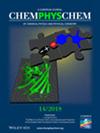Cover Feature: UV–Vis Spectra of Carbonic Acid: Rationalizing Experimental Redshifts between Monomer and Bulk based on (H2CO3)n Calculations (ChemPhysChem 18/2025)
IF 2.2
3区 化学
Q3 CHEMISTRY, PHYSICAL
引用次数: 0
Abstract
The Cover Feature illustrates how irradiation of CO2:H2O ices forms carbonic acid, relevant to interstellar ices like those in Sagittarius B2. Quantum chemical calculations of carbonic acid clusters help interpret infrared and ultraviolet spectra, aiding future identification with telescopes such as JWST or Hubble. More information can be found in the Research Article by R. I. Kaiser, M. Podewitz and co-workers (DOI: 10.1002/cphc.202500282).



封面专题:碳酸的紫外可见光谱:基于(H2CO3)n计算的单体和体间实验红移的理顺(chemphychem 18/2025)
封面特征说明了CO2:H2O冰的辐照是如何形成碳酸的,这与人马座B2中的星际冰有关。碳酸团簇的量子化学计算有助于解释红外和紫外光谱,有助于未来用JWST或哈勃等望远镜进行识别。更多信息可以在R. I. Kaiser, M. Podewitz及其同事的研究文章中找到(DOI: 10.1002/cphc.202500282)。
本文章由计算机程序翻译,如有差异,请以英文原文为准。
求助全文
约1分钟内获得全文
求助全文
来源期刊

Chemphyschem
化学-物理:原子、分子和化学物理
CiteScore
4.60
自引率
3.40%
发文量
425
审稿时长
1.1 months
期刊介绍:
ChemPhysChem is one of the leading chemistry/physics interdisciplinary journals (ISI Impact Factor 2018: 3.077) for physical chemistry and chemical physics. It is published on behalf of Chemistry Europe, an association of 16 European chemical societies.
ChemPhysChem is an international source for important primary and critical secondary information across the whole field of physical chemistry and chemical physics. It integrates this wide and flourishing field ranging from Solid State and Soft-Matter Research, Electro- and Photochemistry, Femtochemistry and Nanotechnology, Complex Systems, Single-Molecule Research, Clusters and Colloids, Catalysis and Surface Science, Biophysics and Physical Biochemistry, Atmospheric and Environmental Chemistry, and many more topics. ChemPhysChem is peer-reviewed.
 求助内容:
求助内容: 应助结果提醒方式:
应助结果提醒方式:


